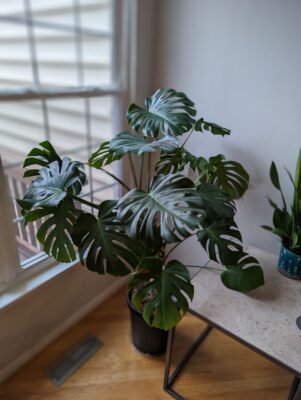The Monstera Deliciosa, also known as the Swiss Cheese Plant, is a popular houseplant admired for its unique, hole-filled leaves. This tropical vine is easy to grow indoors with proper care. In this article we talk about Monstera Deliciosa Care Guide – Tips for Thriving Swiss Cheese Plants.
Table of Contents
Light Requirements

Monstera Deliciosa prefers bright, indirect sunlight. A south or west-facing window is ideal in providing the right amount and intensity of light. Direct sunlight can scorch the leaves, causing brown spots, so filtration with a sheer curtain is recommended. Insufficient light leads to slower growth and smaller leaf fenestrations (holes). Give your Monstera as much bright light as possible without direct sun exposure for best results. Supplement with a grow light if sunlight from windows isn’t enough.
Tip: Rotate your Monstera every few weeks to ensure even light distribution and balanced growth.
Watering Your Monstera
Water thoroughly, allowing the top inch of soil to dry out between waterings. Monsteras prefer slightly moist but not soggy or waterlogged soil. The frequency depends on factors like pot size, sunlight, temperature and humidity but a good general guideline is to water every 1-2 weeks. Water less in winter when growth slows. Check the soil moisture by sticking your finger in the pot and water when the top inch feels dry. Always water until it drains freely from the drainage holes at the bottom.
Tip: Use room-temperature water to avoid shocking the roots and ensure consistent moisture.
Humidity
Monstera Deliciosa thrives in average home humidity but providing 40-60% relative humidity boosts growth and larger leaf holes. Increase moisture with a humidifier nearby or place its pot on a pebble water tray. Misting the leaves also helps but avoid keeping them wet for prolonged periods as that encourages disease.
Tip: For added humidity, group your Monstera with other plants to create a microenvironment with higher moisture levels.
Temperature
Daytime temperatures of 65-80°F (18-27°C) and above 50°F (10°C) at night suit the Monstera. Cooler temperatures below 50°F (10°C) can damage leaves and stunt growth. Avoid drafty areas as the cold dry air causes leaf browning at the edges.
Tip: Use a room thermometer to monitor the temperature and ensure it stays within the ideal range for your Monstera.
Soil
Use a well-draining potting mix, not soil from the garden. Monstera Deliciosa prefers slightly acidic soil with a pH between 6.0-6.5. A general houseplant potting mix amended with perlite, bark chips or pumice provides the fast drainage this tropical plant needs.
Tip: Ensure your pot has drainage holes to prevent water from pooling at the bottom, which can lead to root rot.
Fertilizer
Feed monthly in spring and summer with a balanced liquid fertilizer diluted to half strength. Reduce application to every 6-8 weeks in fall and winter when growth naturally slows. Adding too much fertilizer can burn the roots and leaves so always follow package directions.
Tip: Fertilize after watering to prevent root burn and ensure better nutrient absorption.
Pot Size
Choose a pot one or two sizes larger than the current container, leaving a couple inches between the root ball and edges for future growth. Monsteras have vigorous root systems and prefer being slightly root bound but the pot should allow for adequate drainage and airflow. Avoid overpotting into an excessively large container that stays wet too long.
Tip: Repot during the growing season (spring or summer) for quicker recovery and less transplant shock.
Pruning Monstera Deliciosa
Prune off any dead, damaged or diseased foliage as needed to improve plant health. To encourage bushier growth, pinch or cut back the longest leggy stems. Remove yellow leaves that are past their prime so the plant can focus energy on new growth. Sterilize pruners before each cut with isopropyl alcohol to avoid transmitting disease.
Tip: Use clean, sharp scissors or pruning shears to make precise cuts and reduce stress on the plant.
Propagating Monstera Deliciosa
Propagate Monstera Deliciosa by taking stem tip cuttings with a few leaves or node sections. Place cuttings or nodes in water until roots develop then plant in soil. Monsteras can also be propagated by air layering or planting a leaf node directly into soil. Take advantage of vines that touch the ground by pinning a node to the potting mix until it forms roots.
Tip: Change the water regularly to keep it fresh and encourage faster root development for water propagation.
Repotting Swiss Cheese Plants
Repot during the spring every 2-3 years when roots fill the container. Carefully remove from the old pot then gently loosen tangled sections. Prune any damaged roots then repot into fresh houseplant soil, keeping it at the same level as before. Water well afterwards then place in bright indirect light while it re-establishes.
Tip: Add a layer of gravel or small stones at the bottom of the pot to improve drainage and prevent root rot.
Caring for Monstera Deliciosa Outdoors
Monstera Deliciosa grows well in USDA zones 10-11 as an outdoor ornamental plant but struggles with cold winters farther north. Place outdoors in summer avoiding direct sun exposure then bring back inside before nighttime temperatures drop below 50°F (10°C). Acclimate the plant slowly over 7-10 days when moving locations to prevent shock.
Tip: Use a plant saucer or tray to catch any excess water and protect surfaces from damage.
Common Problems with Monstera Deliciosa
Identifying issues early allows quicker treatment before they worsen. Here are some common Swiss Cheese Plant problems and solutions:
| Problem | Description | Solution |
|---|---|---|
| Leaf yellowing | Usually caused by overwatering or insufficient light. | Allow soil to dry between waterings and provide brighter light. |
| Brown leaf tips/edges | Due to low humidity or inconsistent watering. | Increase humidity levels and water regularly. |
| Leaf holes turning brown | Result of too much direct sun. | Filter sunlight and avoid burning the leaves. |
| Small new leaves | Insufficient light is slowing growth. | Supplement with grow lights or move nearer to a sunny window. |
| Drooping leaves | Can indicate underwatering or overwatering. | Check soil moisture and adjust watering frequency. |
Conclusion
With the proper care outlined here, Monstera Deliciosa makes an easy and rewarding houseplant known for its iconic split leaves. Provide this tropical vine bright indirect sunlight, regular waterings, warm temperatures and moderate humidity for your Swiss Cheese Plant to thrive indoors. I sincerely hope you find this “Monstera Deliciosa Care Guide – Tips for Thriving Swiss Cheese Plants” article helpful.
If you enjoyed this article, you might also like this one: Floating Aquarium Plants Care

